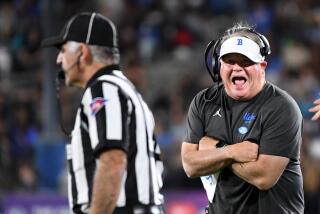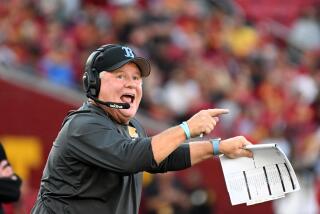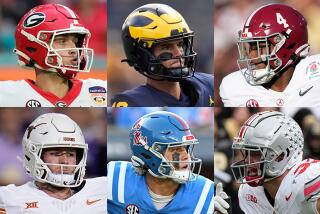Eyes of Texas on Brown Again
- Share via
It is not true that ESPN canceled an episode of “Top 5 Reasons You Can’t Blame Texas Coach Mack Brown for losing five straight to Oklahoma” because no one could think of any reasons.
Here we go again ...
The ambulance chasers are headed to Dallas this week, to the Cotton Bowl, to the Red River Shootout, to watch nice-guy Brown take the best Texas team he has ever had and throw it against the worst Oklahoma team in years.
It is a testament to the way things have gone in this series that not all the smart money is on Brown, despite the fact that:
* Oklahoma is 2-2, lost to Texas Christian, which lost to Southern Methodist, which lost, 66-8, to Texas A&M;, which needed overtime to defeat Baylor.
* Oklahoma lost to UCLA, which almost lost to Washington, which lost to California, 56-17.
* Oklahoma is unranked and starts a redshirt freshman at quarterback.
* Tailback Adrian Peterson, who rushed for 225 yards against Texas last year, is hobbled by a sprained right ankle and missed practice time this week. (Note: Brown isn’t buying any notion Peterson might not play, saying, “If the kids on either side can walk, they play in this game.”)
So what, gulp, could go wrong?
Texas is 4-0, No. 2 in the nation, winner of 11 straight games, defending Rose Bowl champion, and has already passed one gut-check by winning at Ohio State.
This is supposed to be a better team than the one that lost, 12-0, last year. And the one that, two years ago, lost, 65-13. And the one that lost, 63-14, in 2000.
It follows suit that all the great things Brown has done at Texas get overshadowed by the not-so-great things.
If you remove Oklahoma from his resume, Brown is 35-1 in regular-season conference games since 2000 -- and that all means squat this week on the grounds of the Texas State Fair.
Quarterback Vince Young, who ran Michigan ragged in the Rose Bowl and danced around Ohio State defenders a month ago, is betting the “O” in Bevo that Texas won’t get ruled again.
“A lot of the guys on the team, you can ask them, that was the first time ever getting shut out,” Young said of last year’s game. “It was pretty upsetting, pretty stressful. So we don’t want to have that again.”
Why all the Longhorn faces?
Because every time Brown takes the field against Oklahoma you can’t help but cringe.
Brown says his lack of success against the Sooners is “about the only thing I haven’t enjoyed about being at Texas.”
Brown has never shied away from his role in this calamity bake, and rarely mentions that Texas beat Oklahoma his first two years, 1998 and ’99.
He will tell you a new 10-year contract extension has “given me a chance of being the Texas coach instead of worrying about not being the Texas coach.”
Brown’s calm, he would argue, has rubbed off on his veteran team.
Since last year’s loss to Oklahoma, Texas has won big games on big stages. The Longhorns roared back to beat Michigan in the Rose Bowl and refused to buckle against the Buckeyes last month in Columbus.
Brown will say he never set out to be the best coach in Texas history.
“One of the great things about coaching at Texas is you don’t have a legacy,” he said. “Coach [Darrell] Royal is the only one here. He won three national championships. And that’s probably not going to happen again.”
That’s not to suggest Brown hasn’t tried everything short of an exorcism to break the Oklahoma jinx. He has changed practice routines and interview schedules -- to no avail.
Brown even sought counsel from Florida State Coach Bobby Bowden, who was 11-19 against Miami entering this year and had lost six in a row in the series before breaking through with a victory on Labor Day weekend.
“I love talking to Coach Bowden about it because he’s struggled with Miami some,” Brown said. “And he’d say, ‘One year I didn’t talk about them at all, and we got beat, one year I talked about them all the time and we got beat, another year I talked about them some and we got beat.’ He said, ‘I figure they just must be playing better than we are.’
“So, it is fun to look around to see other people who are having the same problem. They don’t have the answer either.”
Going 2-10-1 against Michigan probably cost Ohio State’s John Cooper his job.
Brown doesn’t have such concerns at the moment, but check back Saturday.
Georgia Bound
The Sugar Bowl will announce Friday that this year’s game will be played Jan. 2 at Atlanta’s Georgia Dome, a bowl championship series source said.
In the aftermath of Hurricane Katrina, which badly damaged the Louisiana Superdome, the Sugar Bowl had prepared parallel plans to play in either Baton Rouge or Atlanta, but a lack of hotel rooms and other concerns in storm-ravaged New Orleans -- the host to most related pregame festivities -- made it clear early on that the game would have to be moved.
Poll Gets a ‘Trim’
Trying to understand the Harris Interactive College Football poll, Part III: There were only 112 voters in the second index, two less than the 114 Harris started out with, and the tally of 36,406 points exceeded by six the highest total possible.
Huh?
On the first question, a Harris spokesperson says one voter did not submit his ballot and a second ballot got tossed because it could not be verified despite “multiple attempts to contact the panelist.”
For the second issue, we turned to Renee Smith, senior research scientist and director for Harris.
It seemed a simple question: “How could there be more points in the poll than possible points?”
Smith then explained the scientific process of “trimming.”
She said if there is a wild deviation of a ranking among the top-15 schools -- say Team X from Columbus is in everyone’s top 10 but one Harris voter from Michigan has Team X ranked 24th -- the Harris poll will “adjust” that vote up.
Smith said this is not manipulating individual votes, but keeping the process scientifically sound.
In this case, a team would receive more votes than total points -- which is what happened this week.
Conversely, an extremely high point value would be trimmed down, producing a lower point total.
“After the rankings are submitted we run diagnostic tests on point totals,” Smith said. “After that, we use very common statistical practice.”
Just a wild guess here, but it seems this “trimming” process could get interesting in December if it affects the final BCS standings.
The Harris poll is replacing the Associated Press poll in this year’s BCS, and the last thing anyone needs is a repeat of “Texas-Cal.”
Smith said she was aware college football fans were passionate about their schools and that some even miss class to monitor BCS computer developments.
“We are as passionate about getting it right,” Smith said.
More Harris updates as they become available.
Instant Reply
Here’s the line score so far for instant replay in the Pac-10: 26 games, 34 stoppages, 13 reversals, average length of stoppage: 1:54 and, last weekend, a lot of head scratching.
“We’re working our way through it,” UCLA Coach Karl Dorrell calmly noted.
Events of last weekend at times made you wonder whether the conference needed a replay system to monitor the replay system.
In the first quarter of the USC-Arizona State game, Trojan tailback Reggie Bush was ruled on the field to have made a one-handed catch on the sideline.
The catch was overturned by the replay official in the booth.
“That was an incorrect reversal,” Verle Sorgen, the Pac-10’s coordinator of football officiating, said this week. “That play should have stayed.”
In a much more confusing play later Saturday, UCLA thought it had recovered a goal-line fumble by Washington tailback Kenny James.
Instead, Washington kept the ball just short of the goal.
Asked this week on the Pac-10 coaches’ conference call if he had received a satisfactory answer as to what happened, Dorrell chuckled and said, “No.”
Sorgen explained it this way: The official on the field “incorrectly” ruled James had scored a touchdown, at which point the play was dead.
On review, it was determined that James did not score, so Washington was awarded the ball at the point where the runner’s forward progress was stopped.
“We did that one right,” Sorgen said. “Instant replay was right and the ruling on the field was incorrect.”
Sorgen says many of replay’s kinks still need to be worked out.
For example, four plays reviewed during USC-Arizona State helped to extend the game, on a brutally hot day, to four hours and three minutes.
“One stoppage we should not have had,” Sorgen said of the Bush reversal, “and the others should have gone faster.”
Somewhat surprisingly, Pac-10 coaches seem willing to give replay a chance.
Dorrell was initially opposed to the idea, but now says, “I think it will work out.”
Arizona’s Mike Stoops and Oregon State’s Mike Riley say they would prefer the NFL system that allows coaches to challenge calls from the field. All Pac-10 replay reviews are initiated from an official in the press box.
Overall, though, Riley said, “I’ve got a positive assessment of it.”
Arizona State Coach Dirk Koetter did not want replay in the Pac-10 but now says, “I’ve been pleasantly surprised” with its impact.
Sorgen says replay is a work in progress.
“We ought to hold off on any decisions,” he said. “We’ve only gone through five weeks. I’m not trying to excuse replay, but maybe we need a little bigger sample to see where we stand. Then maybe we could fine-tune it.”
More to Read
Go beyond the scoreboard
Get the latest on L.A.'s teams in the daily Sports Report newsletter.
You may occasionally receive promotional content from the Los Angeles Times.











